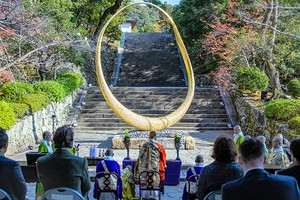THE ASAHI SHIMBUN
April 12, 2022 at 17:51 JST
CHERNIHIV, Ukraine—Around a dozen bombed out apartment buildings of at least 10 floors appeared on the verge of collapse in this northern Ukrainian city, while roads were covered with debris and burnt cars.
Chernihiv Mayor Vladyslav Atroshenko, 53, said other horrors from the monthlong Russian bombardment of the city remain hidden.
“We believe there are bodies buried beneath the rubble that could not be recovered,” he said.
Accompanied by Ukrainian officials, reporters from The Asahi Shimbun entered the city on April 9 to see the destruction.
Using a familiar tactic in its invasion of Ukraine that started on Feb. 24, the Russian military surrounded the city and then pounded it with continuous bombings and shellings.
Russian troops only recently departed Chernihiv, leaving behind death, destruction and anger.
The bombing started in the central part of Chernihiv on March 3. According to city government officials, about 49 residents died when at least six bombs fell on what was once a quiet residential area.
Opposite the teetering apartment buildings stands a hospital that specializes in treating people with heart ailments.
Atroshenko said a patient there was supposed to meet her husband in front of the hospital. But she was late, which saved her life.
A bomb is believed to have directly hit her husband at their meeting spot. His remains have not been found.
“According to what residents have said, the bomber flew at an altitude of a few hundred meters, so the pilot clearly knew that this was a residential area with no connection to the military,” Atroshenko said.
Another Russian bombardment about 2 kilometers to the east seriously damaged a soccer stadium named for Yuri Gagarin, the Russian cosmonaut who was the first man to fly in space.
The stadium seats were destroyed, and a bomb created a hole several meters deep in the middle of the pitch.
With a population of about 300,000, Chernihiv is known for its many architectural works, such as cathedrals and monasteries, that remain from the 12th and 13th centuries.
But because Chernihiv is located only several dozen kilometers from the borders with Russia and Belarus, it was one of the first cities targeted by the Russian military.
For about a month from early March, Chernihiv was completely surrounded, and residents had no way of fleeing.
According to city officials, between 200 and 250 civilians died within the city, and total fatalities, including military personnel, exceeded 700.
NEARBY VILLAGE DEVASTATED AGAIN
The damage to outlying areas of the city was even greater.
Pre-invasion pictures of Novoselivka, a village of about 700 residents directly east of Chernihiv, showed green farm fields.
Now, all homes on a stretch of several hundred meters along a major thoroughfare to the center of the village have been damaged or destroyed.
“My home was destroyed in a bombing at about 5 a.m. on March 11,” a 57-year-old resident said. “We only managed to survive because we were in the underground basement.”
After surrounding Chernihiv, Russian troops also attacked Novoselivka on an almost daily basis.
According to officials of Chernihiv province, many residents survived the onslaught by finding shelter in basements that are prevalent in the area.
But there is still no clear idea of how many people actually died because there has not been enough time to look into the situation since the Russians left in early April.
A 53-year-old hospital employee was cleaning up what was left of his home.
“This was a very pleasant village to live in because public utilities, such as water supply and gas, were in place,” he recalled.
He said he fled to the basement at his home whenever an attack occurred. But on March 15, he finally moved to a residence in the center of Novoselivka.
He said the village had also been devastated by Nazi Germany during World War II.
“The village had a different name before the war, but after it was burned down, it began a second life as Novoselivka from 1952,” he said. “So this is the second time the village has been turned into a wasteland.”
However, he added, “We will rebuild once again, although that will only happen after the fighting ends.”
(This article was written by Norito Kunisue and Tetsuro Takehana.)




















A peek through the music industry’s curtain at the producers who harnessed social media to help their idols go global.
A series based on diplomatic documents declassified by Japan’s Foreign Ministry
Here is a collection of first-hand accounts by “hibakusha” atomic bomb survivors.
Cooking experts, chefs and others involved in the field of food introduce their special recipes intertwined with their paths in life.
A series about Japanese-Americans and their memories of World War II